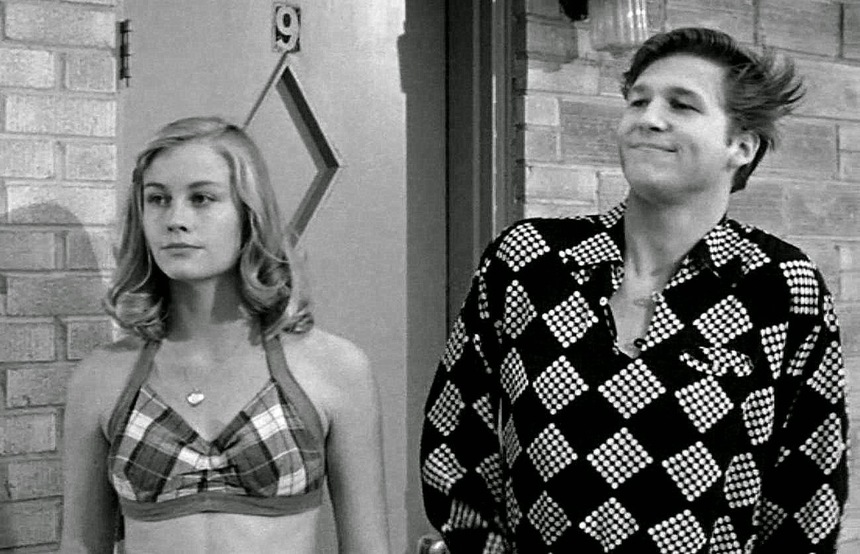10+ Years Later: Does THE LAST PICTURE SHOW Still Play?

For whatever reason, Peter Bogdanovich's 1971 career-igniter The Last Picture Show had been rattling around in my mind. A hazy lone monochrome mental tumbleweed ambling through every now and then.
Although I've read about it at length in numerous books and articles over the years, not the least of which being Peter Biskind's Easy Riders, Raging Bulls, I'd only actually seen the film, beginning to end, once. That was back in college, which means it was half my lifetime ago.
I wasn't sure why the film, with its greyed-out, desolate vibe had started kicking around upstairs, yet there it was. Then one day, doing the dishes and listening to a recent Jeff Bridges interview on the radio show Fresh Air, it came up that the actor's latest, Hell or High Water, is a nice kind of current career bookend taking him back to the decaying Texas aesthetic where he started out.
Based on a semi-autobiographical novel by Larry McMurtry, The Last Picture Show chronicles the exploits of an array of teenagers in 1951 in the fictionalized small town of Anarene. Bridges, along with Bogdanovich himself, was just one of many players involved whom would go on to be a major talent. The film, like American Graffiti, Fast Times at Ridgemont High and Dazed and Confused, is one of those that happened to introduce the world to a whole host of future-famous fresh faces. Cybill Shepherd, Ellen Burstyn, Randy Quaid, Timothy Bottoms, Sam Bottoms, and more are among the cast.
Having seen it so long ago, the only clear memories I had of the film were these:
-
Sam the Lion (an Oscar-winning, late-career Ben Johnson) reminiscing by the river, just before he dies off screen. I didn't recall, however, what he was reminiscing about.
-
Cybill Shepherd taking all her clothes off on the diving board. This memory should need no explanation.
-
The local movie theater closes at the end.
Ah. Number three. Dare I say, maybe that's it?
In 1971, the melancholy final shot of the newly shuttered cinema evoked a different meaning than we're likely to project today. It was the age of New Hollywood, a landscape of greatly shifting sands. The venerable old guard of Hawks, Hitchcock, Ford, et cetra weren't just aging out, but were being actively rejected by the rising counter cultural youth movement.
BBS, the filmmaking outfit that brought forth The Last Picture Show, was at the absolute cinematic forefront of it all. Financially flush from the overwhelming success of Dennis Hopper's Easy Rider, Bogdanovich's film would provide yet another windfall to their coffers. Per the emboldened BBS narrative of the day, the closing of the old tyme movie house wasn't so much about "the death of cinema" as a shifting of the guard. Today though, even more so than my college age, it is very much the former that is undeniably evoked.
Whether or not cinema is truly dying or not, what with streaming video, the internet, video games and whatever else taking over, is beside the point. The point is that the argument, for cinephiles, has proven inescapable. And dare I say, perhaps Bogdanovich, who'd grown personally close to the likes of the ostracized Howard Hawks, John Ford and Orson Welles, was more sympathetic to the former, "death of cinema" point of view? The Last Picture Show is nothing if not mournful of what is being lost.
In his previous film, Targets, panicked audiences were driven from an active drive-in by a sniper hiding in the screen itself. This time, it is the death of John Ford stock player Ben Johnson that keeps filmgoers away. Even as Bogdanovich helped usher in the new parameters and boundaries of Hollywood with the film's frank sexuality, he was lamenting the palpable death of the movie heritage his BBS cohorts were busy trying to kill.
I'd venture to argue that although things have definitely changed, cinema is far from dead. It's okay to feel that way from time to time, but don't altogether believe it. New films such as Bridges' Hell or High Water evidence undeniably a pounding pulse, even as it wallows in disintegrating Texas towns.
When I first saw The Last Picture Show all those years ago, I came away appreciative but not moved. This, despite the fact that several trusted film-loving fans have long and warmly proclaimed it. Looking at it now, I've finally caught up with them. Some of the nits that kept me at a distance then remain today. Distractingly, young Timothy Bottoms, Jeff Bridges and Sam Bottoms look too much alike, as do, at times, Ellen Burstyn and Eileen Brennan. My problem, I know. But other things, like the wall-to-wall Hank Williams tunes that occupy the soundscape of this world, resonate now newly and deeply.
The Last Picture Show didn't start a fire nor extinguish one. But as a bittersweet tale of teenagers that is both achingly nostalgic and bluntly forward, Bogdanovich's film - still his best to date - is a rich and timeless bit of our celluloid heritage. I'm happy to have strolled down its memory lane.






